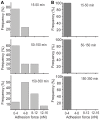Rapid and serial quantification of adhesion forces of yeast and Mammalian cells
- PMID: 23285166
- PMCID: PMC3527581
- DOI: 10.1371/journal.pone.0052712
Rapid and serial quantification of adhesion forces of yeast and Mammalian cells
Abstract
Cell adhesion to surfaces represents the basis for niche colonization and survival. Here we establish serial quantification of adhesion forces of different cell types using a single probe. The pace of single-cell force-spectroscopy was accelerated to up to 200 yeast and 20 mammalian cells per probe when replacing the conventional cell trapping cantilever chemistry of atomic force microscopy by underpressure immobilization with fluidic force microscopy (FluidFM). In consequence, statistically relevant data could be recorded in a rapid manner, the spectrum of examinable cells was enlarged, and the cell physiology preserved until approached for force spectroscopy. Adhesion forces of Candida albicans increased from below 4 up to 16 nN at 37°C on hydrophobic surfaces, whereas a Δhgc1-mutant showed forces consistently below 4 nN. Monitoring adhesion of mammalian cells revealed mean adhesion forces of 600 nN of HeLa cells on fibronectin and were one order of magnitude higher than those observed for HEK cells.
Conflict of interest statement
Figures






Similar articles
-
Bacterial adhesion force quantification by fluidic force microscopy.Nanoscale. 2015 Mar 7;7(9):4070-9. doi: 10.1039/c4nr06495j. Nanoscale. 2015. PMID: 25660231
-
A modular atomic force microscopy approach reveals a large range of hydrophobic adhesion forces among bacterial members of the leaf microbiota.ISME J. 2019 Jul;13(7):1878-1882. doi: 10.1038/s41396-019-0404-1. Epub 2019 Mar 20. ISME J. 2019. PMID: 30894689 Free PMC article.
-
FluidFM as a tool to study adhesion forces of bacteria - Optimization of parameters and comparison to conventional bacterial probe Scanning Force Spectroscopy.PLoS One. 2020 Jul 6;15(7):e0227395. doi: 10.1371/journal.pone.0227395. eCollection 2020. PLoS One. 2020. PMID: 32628681 Free PMC article.
-
Extending applications of AFM to fluidic AFM in single living cell studies.J Cell Physiol. 2022 Aug;237(8):3222-3238. doi: 10.1002/jcp.30809. Epub 2022 Jun 13. J Cell Physiol. 2022. PMID: 35696489 Free PMC article. Review.
-
Statistical analysis of long- and short-range forces involved in bacterial adhesion to substratum surfaces as measured using atomic force microscopy.Appl Environ Microbiol. 2011 Aug;77(15):5065-70. doi: 10.1128/AEM.00502-11. Epub 2011 Jun 3. Appl Environ Microbiol. 2011. PMID: 21642399 Free PMC article. Review.
Cited by
-
Single-Cell Force Spectroscopy of Als-Mediated Fungal Adhesion.Anal Methods. 2013 Aug 7;5(15):3657-3662. doi: 10.1039/C3AY40473K. Anal Methods. 2013. PMID: 23956795 Free PMC article.
-
Microfluidic device combining hydrodynamic and dielectrophoretic trapping for the controlled contact between single micro-sized objects and application to adhesion assays.Lab Chip. 2023 Aug 8;23(16):3593-3602. doi: 10.1039/d3lc00400g. Lab Chip. 2023. PMID: 37458004 Free PMC article.
-
Sensing and Modelling Mechanical Response in Large Deformation Indentation of Adherent Cell Using Atomic Force Microscopy.Sensors (Basel). 2020 Mar 22;20(6):1764. doi: 10.3390/s20061764. Sensors (Basel). 2020. PMID: 32235792 Free PMC article.
-
Cell Adhesion on Dynamic Supramolecular Surfaces Probed by Fluid Force Microscopy-Based Single-Cell Force Spectroscopy.ACS Nano. 2017 Apr 25;11(4):3867-3874. doi: 10.1021/acsnano.7b00161. Epub 2017 Mar 22. ACS Nano. 2017. PMID: 28319669 Free PMC article.
-
Differential cellular responses to adhesive interactions with galectin-8- and fibronectin-coated substrates.J Cell Sci. 2021 Apr 15;134(8):jcs252221. doi: 10.1242/jcs.252221. Epub 2021 Apr 27. J Cell Sci. 2021. PMID: 33722978 Free PMC article.
References
-
- Baror Y (1990) The effect of adhesion on survival and growth of microorganisms. Experientia 46: 823–826.
-
- An YH, Friedman RJ (1997) Laboratory methods for studies of bacterial adhesion. Journal of Microbiological Methods 30: 141–152.
-
- Ashkin A, Dziedzic JM (1987) Optical trapping and manipulation of viruses and bacteria. Science 235: 1517–1520. - PubMed
-
- Walter N, Selhuber C, Kessler H, Spatz JP (2006) Cellular unbinding forces of initial adhesion processes on nanopatterned surfaces probed with magnetic tweezers. Nano Letters 6: 398–402. - PubMed
Publication types
MeSH terms
Grants and funding
LinkOut - more resources
Full Text Sources
Miscellaneous

